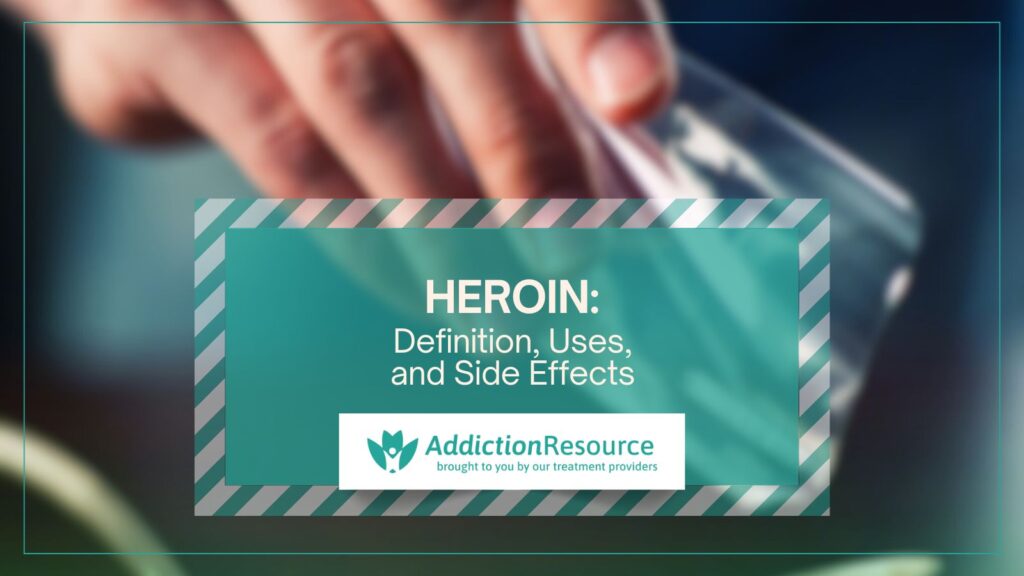
Heroin is a highly addictive illegal opioid or drug made from morphine, a natural compound found in the opium poppy plant, and is known for its high potential for addiction due to its significant impact on brain and body functions. Heroin is available in three main forms: white powder, brown powder, and black tar heroin, with the latter being the least refined and characterized by a sticky, tar-like texture. Some street names for heroin are smack, junk, dope, horse, and brown sugar.
According to the 2021 National Survey on Drug Use and Health, 0.4% (or about 1.1 million people) aged 12 or older reported using heroin in the past 12 months in 2021. According to the 2022 Monitoring the Future Survey, among students, an estimated 0.3% of 8th graders, 0.2% of 10th graders, and 0.3% of 12th graders reported using heroin in the past 12 months.
Uses of heroin include consumption through various methods such as injecting, smoking, or snorting. Each method has distinct techniques, including “mainlining” for intravenous use, “chasing the dragon” for smoking, and inhaling powdered heroin through the nose.
People who use heroin recreationally or due to addiction experience side effects like a brief feeling of euphoria, pinpoint pupils (miosis), and a slower heart rate (bradycardia). Chronic users of heroin suffer from serious health problems like infections in the heart lining (endocarditis), liver damage (hepatotoxicity), and slowed or impaired breathing (respiratory depression).
According to the CDC WONDER Database, in 2021, approximately 9,173 people died from an overdose involving heroin. Heroin use disrupts the brain’s reward system and leads to dependence and severe addiction.
Table Of Contents:
What is Heroin?
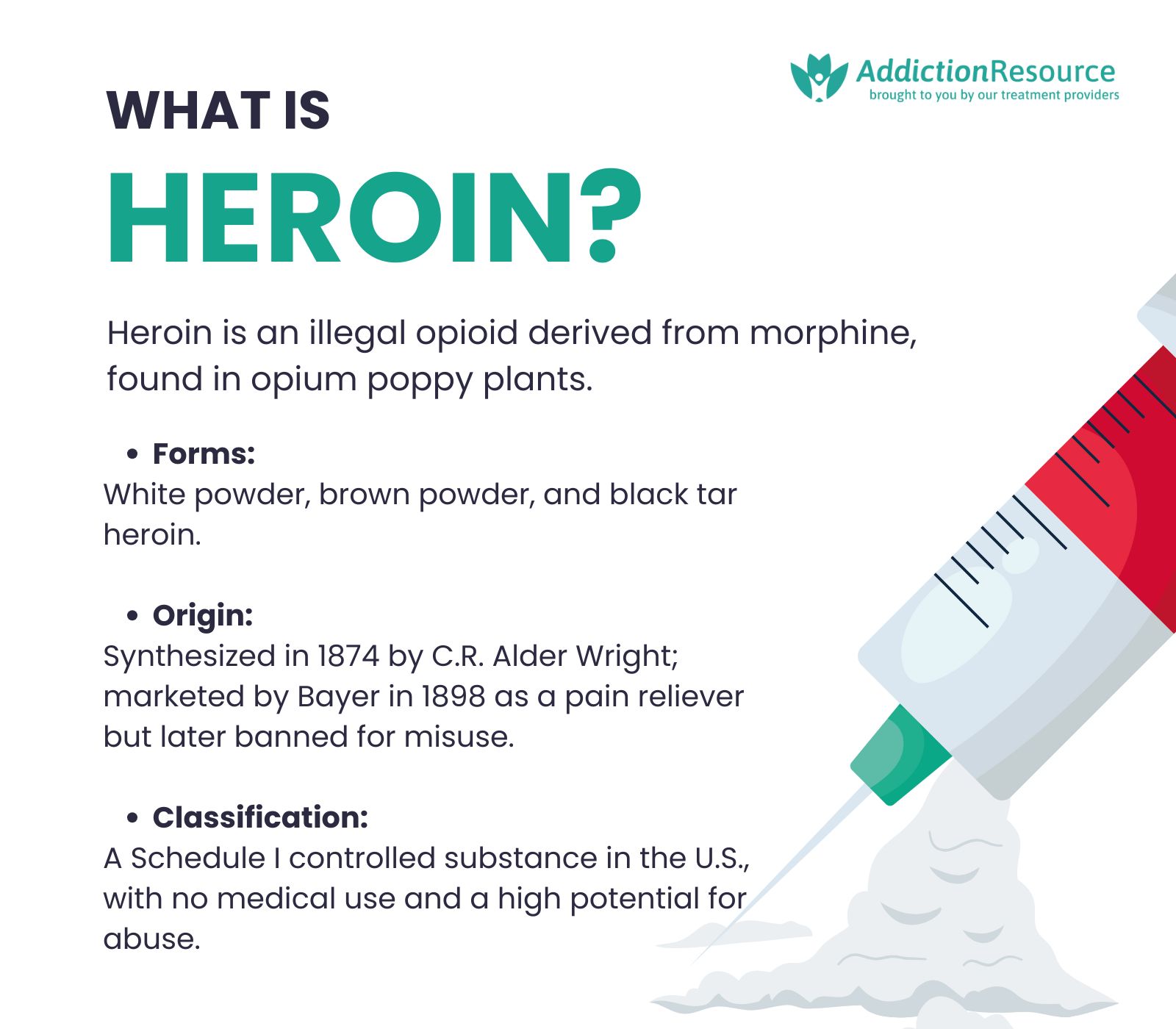
More About Opioids:
Heroin is an opioid drug made from morphine, a natural compound found in the seed pods of the opium poppy plant (Papaver somniferum), according to the research report titled “What is heroin and how is it used?” published by the National Institute on Drug Abuse. Heroin is considered highly addictive because it severely affects both brain and body functions. Heroin comes in three main forms, white powder, brown powder, and black tar heroin. Black tar heroin is the least refined form of heroin with a sticky and tar-like texture, produced in regions like Mexico, Colombia, Southeast Asia, and Southwest Asia.
English chemist named C.R. Alder Wright first created heroin by synthesizing it from morphine in 1874. Pharmaceutical company Bayer introduced heroin as a treatment for pain and as a cough suppressant later in 1898, but people started misusing it as a recreational drug widely. addictive properties soon led to misuse. The United States officially categorized heroin as a Schedule I controlled substance in 1970 after recognizing its high potential for abuse and lack of any accepted medical use, according to “CHAPTER 13—DRUG ABUSE PREVENTION AND CONTROL”.
What are the Street Names of Heroin?
The street names of heroin are Big H, Chiva, Hell Dust, Horse, Negra, Smack, Thunder, Dope, Skag, China White, Home Bake, Brown, and Hero, according to the article titled “Drug Slang Code Words” by DEA. GOV.
These street names are listed below.
- Big H: Big H is short for heroin, and highlights the powerful and dangerous characteristics of the drug.
- Chiva: Chiva originates from the Spanish word for goat but refers to heroin in drug slang. Chiva is used in Latin American communities and highlights the drug’s presence in those regions.
- Hell Dust: Hell dust refers to how destructive heroin is and the pain and suffering the drug causes in people’s lives.
- Horse: Horse is slang for heroin, referring to the powerful “ride” or rush it gives users.
- Negra: Negra means black in Spanish and is used to describe dark-colored heroin, especially black tar heroin.
- Smack: Smack refers to the quick and intense euphoria heroin gives to users as if they were hit with a huge ball of pleasure.
- Thunder: Thunder refers to the powerful effects heroin has on the body just like a thunderclap.
- Dope: Dope is a general term for drugs but is used specifically for heroin. Dope is a common slang word in many drug communities.
- Skag: Skag is a British slang term for heroin and reflects the harsh and dangerous lifestyle tied to heroin use.
- China White: China white is a name for pure, white heroin. China white heroin is very powerful and more dangerous due to its high strength.
- Home Bake: Home Bake refers to heroin made using homemade methods. Home bake heroin is impure and dangerous because it’s made with crude ingredients.
- Brown: Brown is a term for heroin in its brown powder form. This form is less refined than white heroin and more affordable but still highly addictive.
How Does Heroin Work in the Body?
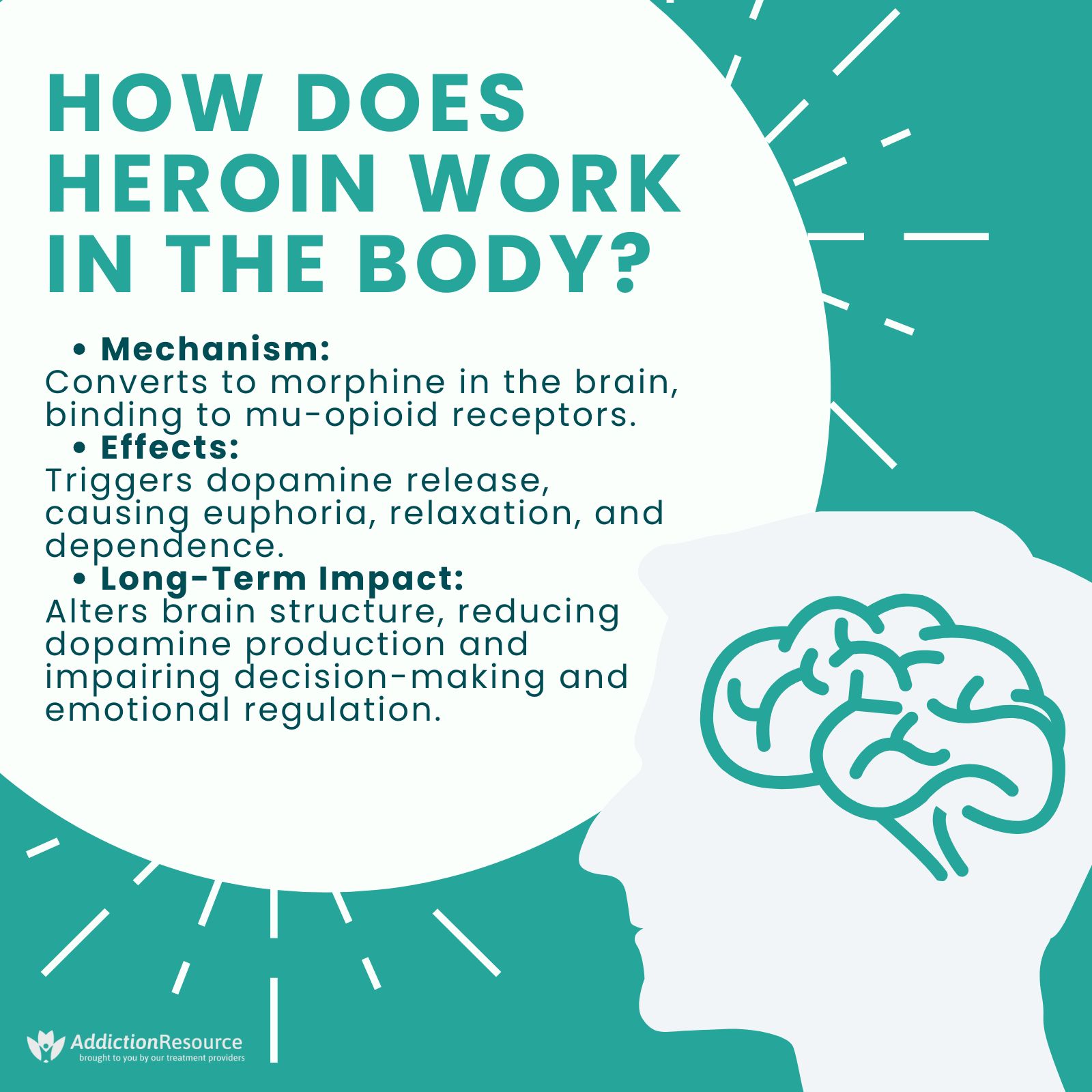
Heroin works in the body by interacting with the brain’s opioid receptors, which help control pain, emotions, and feelings of reward. Heroin quickly reaches the brain and converts into morphine after entering the bloodstream. Morphine then binds to special receptors in the brain called mu-opioid receptors. This triggers the release of dopamine, a chemical that creates intense euphoria, pleasure, and relaxation. The release of dopamine disturbs the normal brain function and overstimulates the reward system, according to the study titled “Neurobiologic Advances from the Brain Disease Model of Addiction” by Nora D. Volkow, and George F. Koob. Long-term heroin use changes the brain’s structure and reduces its natural ability to produce dopamine. Users become more dependent as a result and need larger doses to feel the same effects, which leads to addiction.
How is Heroin Consumed?
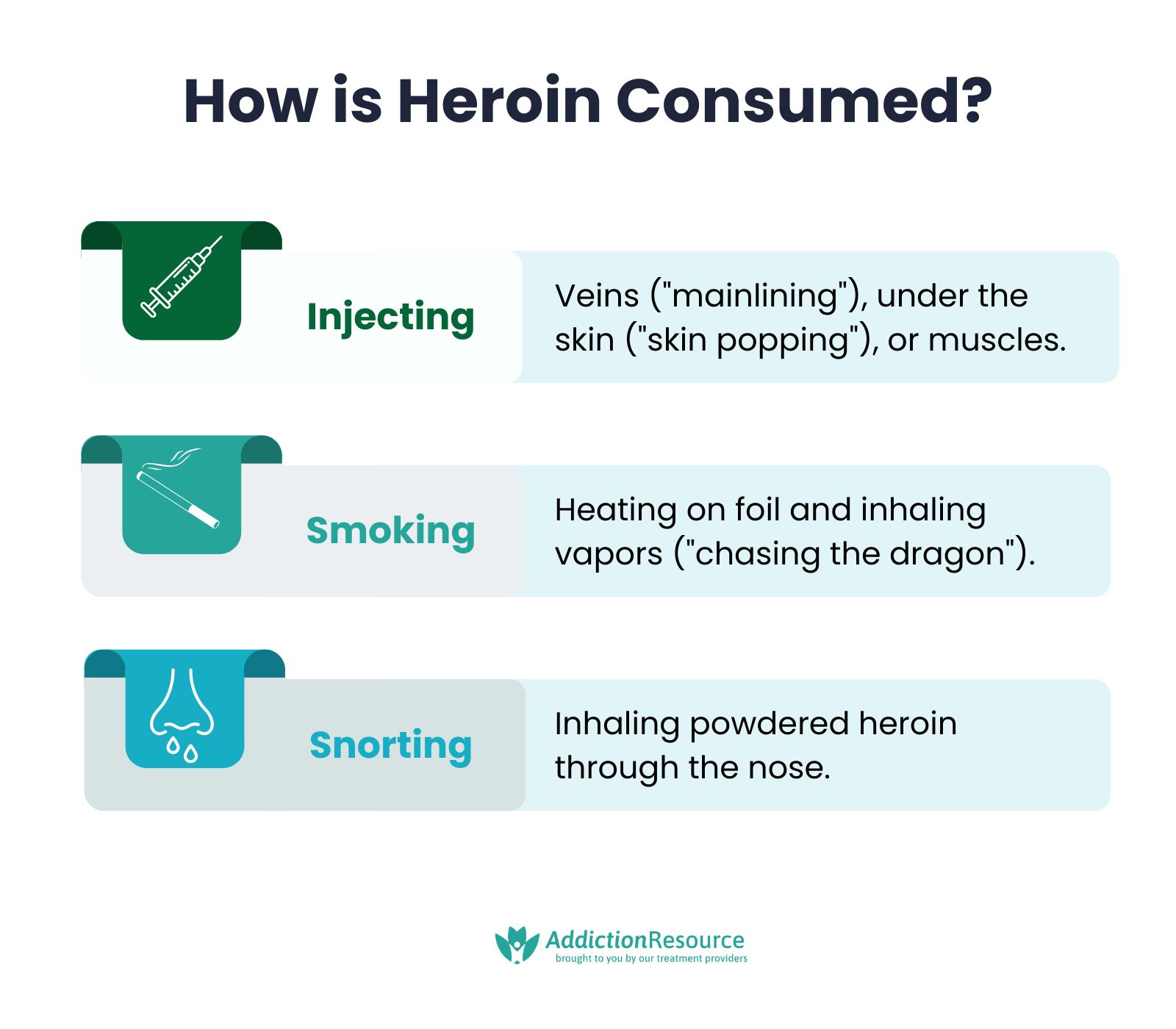
Heroin is consumed in the form of injecting, smoking, or snorting. People who inject heroin use needles and syringes to deliver the drug into their veins, muscles, or just under the skin. Injecting heroin directly into a vein for a fast high is called “mainlining.” Injecting heroin under the skin is called “skin popping,” and injecting it into a muscle is called intramuscular injection. Smoking heroin called “chasing the dragon,” involves heating the drug on foil and inhaling the vapors. Snorting heroin refers to inhaling powdered heroin through the nose, which leads to nasal irritation over time.
What are the Effects of Heroin Use?
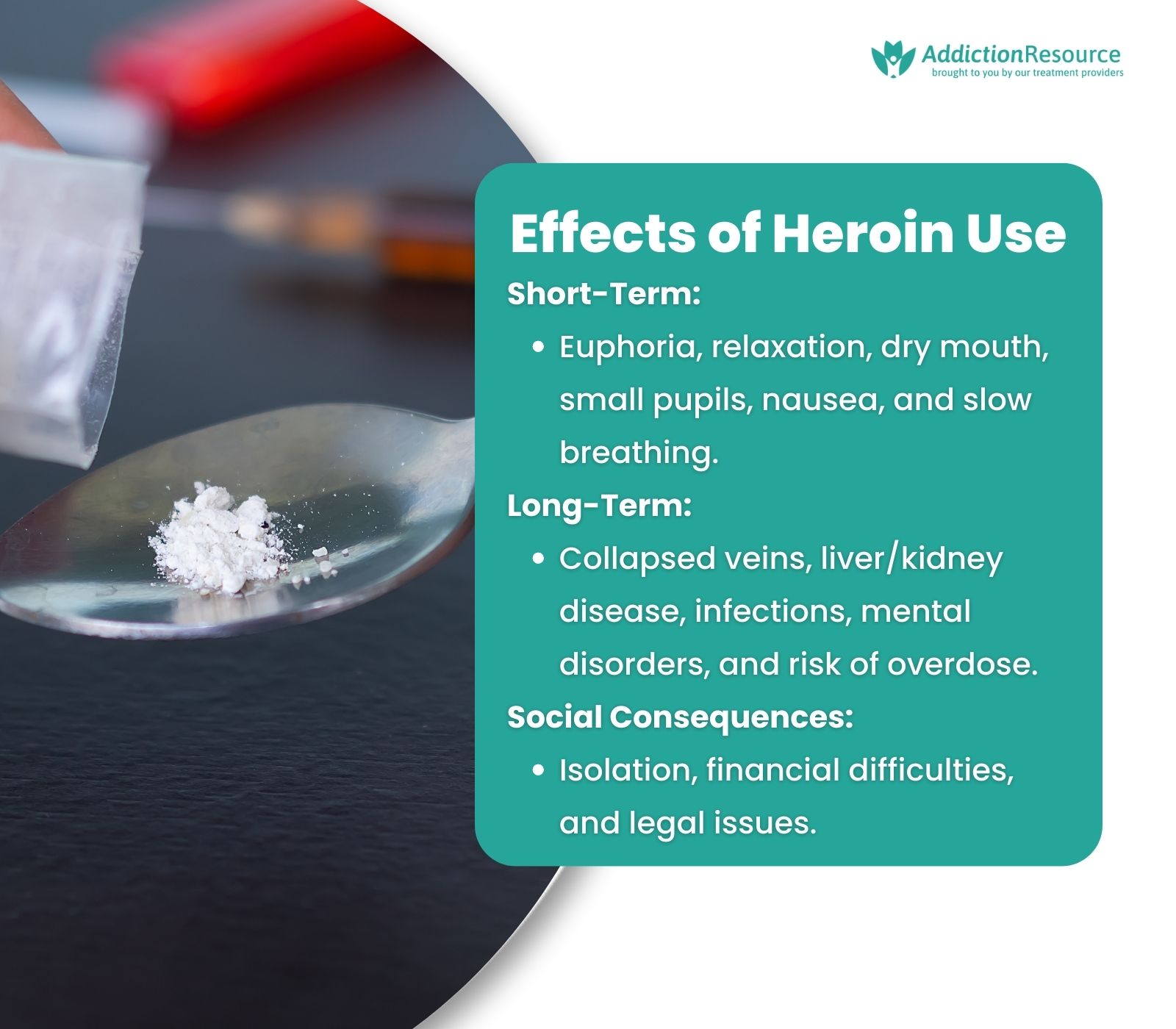
The effects of heroin use are short-term and long-term, including euphoria, dry mouth, itching, confusion, small pupils, liver and kidney disease, collapsed veins, menstrual problems, miscarriage, and risk of overdose, according to the “Commonly Used Drugs Charts” published by the National Institute on Drug Abuse.
These effects of heroin are listed below in detail.
- Euphoria: Euphoria is a short-term side effect of heroin that causes intense happiness and relaxation by binding to opioid receptors.
- Pain Relief: Pain relief is a short-term effect that reduces physical pain by blocking the pain signals in the body.
- Relaxation: Relaxation is a short-term effect of heroin that creates calmness and reduces anxiety through its depressant effects.
- Dry Mouth: Dry mouth is a short-term effect of heroin that decreases saliva production, which causes a persistent dry sensation in the mouth.
- Heavy Feeling in the Arms and Legs: Heavy feeling in the arms and legs is a short-term effect after heroin causes a feeling of weightiness in the limbs shortly after use.
- Itching: Heroin triggers histamine release in the body, which leads to constant skin itching.
- Nausea and Vomiting: Nausea and vomiting is a short-term effect that occurs after heroin affects the digestive system and brain stem, especially for first-time users.
- Confusion and Clumsiness: Confusion and clumsiness occur after heroin disturbs the brain activity and impairs cognitive function and motor coordination.
- Feelings of Detachment: Feelings of detachment occur after heroin interrupts normal brain function and makes users feel disconnected from reality.
- Slurred and Slow Speech: Slurred and slow speech is a short-term effect after heroin slows neural activity and users start speaking in a sluggish manner.
- Slow Breathing and Heartbeat: Slow breathing and heartbeat occur after heroin suppresses respiratory and cardiac rates, which becomes life-threatening in some cases.
- Warm, Flushed Skin: Heroin dilates blood vessels and creates a sensation of warmth and redness in the skin.
- Lack of Hunger: Lack of hunger is a long-term effect after heroin suppresses appetite by disturbing the centers of the brain responsible for regulating hunger.
- Small Pupils: Small pupils are a long-term effect because regular heroin constricts pupils and makes them pinpoint.
- No Interest in Sex: Heroin reduces sexual desire for the long term after disrupting hormonal balances in users.
- Drowsiness: Drowsiness is a long-term effect that involves constantly nodding off because heroin slows brain activity.
- Mental Clouding: Mental clouding is a long-term effect that occurs after heroin impairs cognitive functions by reducing mental clarity and alertness in addicts. This impairment slows down concentration and decision-making.
- Constipation: Constipation is a long-term effect that occurs after heroin impairs bowel function. People with a heroin addiction have difficulties passing stools, and some people suffer from infrequent bowel movements.
- Strong Feeling of Sadness: A strong feeling of sadness is the chronic depressive state after heroin disrupts neurotransmitter balance. People with a heroin addiction feel constant depression and emotional ups and downs.
- Collapsed Veins: Heroin addicts repeatedly use injections that damage blood vessels, which leads to collapsed veins.
- Insomnia: Insomnia is a long-term effect that occurs after heroin disturbs sleep patterns and makes it difficult to fall asleep.
- Infections of the Heart Lining and Valves: Heroin addicts use non-sterile injections that introduce bacteria into the bloodstream. These unhygienic heroin injections cause infections of the heart lining and valves, including abscesses and cellulitis.
- Higher Risk of HIV, Hepatitis B, and Hepatitis C: A high risk of HIV, hepatitis B, and Hepatitis C occurs after sharing needles that expose users to these viruses and severe blood-borne infections.
- Liver and Kidney Disease: Heroin use damages major organs over time and increases the risk of liver and kidney failure.
- Trouble Getting an Erection: Heroin reduces testosterone levels and leads to erectile dysfunction in men.
- Mental Disorders: Mental disorders are long-term effects as heroin increases the risk of anxiety, paranoia, and depression.
- Lung Diseases Like Pneumonia and Tuberculosis: Heroin causes respiratory infections affecting the lungs. People with an addiction are vulnerable to respiratory diseases due to their weakened immune systems.
- Menstrual Problems and Miscarriage: Heroin causes hormonal imbalances problems like menstrual irregularities and increased miscarriage risks in women.
- Social Isolation: Social isolation is a long-term effect after heroin use leads to withdrawal from personal relationships and neglect of social responsibilities.
- Financial Difficulties: Financial difficulties occur after individuals use all their money to purchase heroin, which is expensive because it is illegal.
- Legal Issues: Heroin addiction involves illegal activities that result in arrests and legal consequences.
- Overdose Risk: Prolonged heroin use increases the risk of overdosing due to decreased tolerance and engaging in risky behaviors.
How Does Heroin Affect the Brain?
Heroin affects the brain by damaging its key areas, particularly the white matter in the prefrontal cortex, which is responsible for decision-making, controlling emotions, and managing stress, according to the “Heroin Research Report” conducted by the National Institute on Drug Abuse (NIDA). This damage makes it harder to think clearly, regulate emotions, and handle everyday challenges. Heroin also dulls the brain’s response to natural rewards, making ordinary activities feel less enjoyable and pushing users deeper into addiction. Regular heroin users feel mood swings and symptoms of anxiety and depression, specifically during the withdrawal phase when their high or trip is coming to an end. Heroin users constantly deal with mental fog or cloudiness, which makes it hard to focus or perform on work, school, and daily tasks.
What is Heroin Addiction?
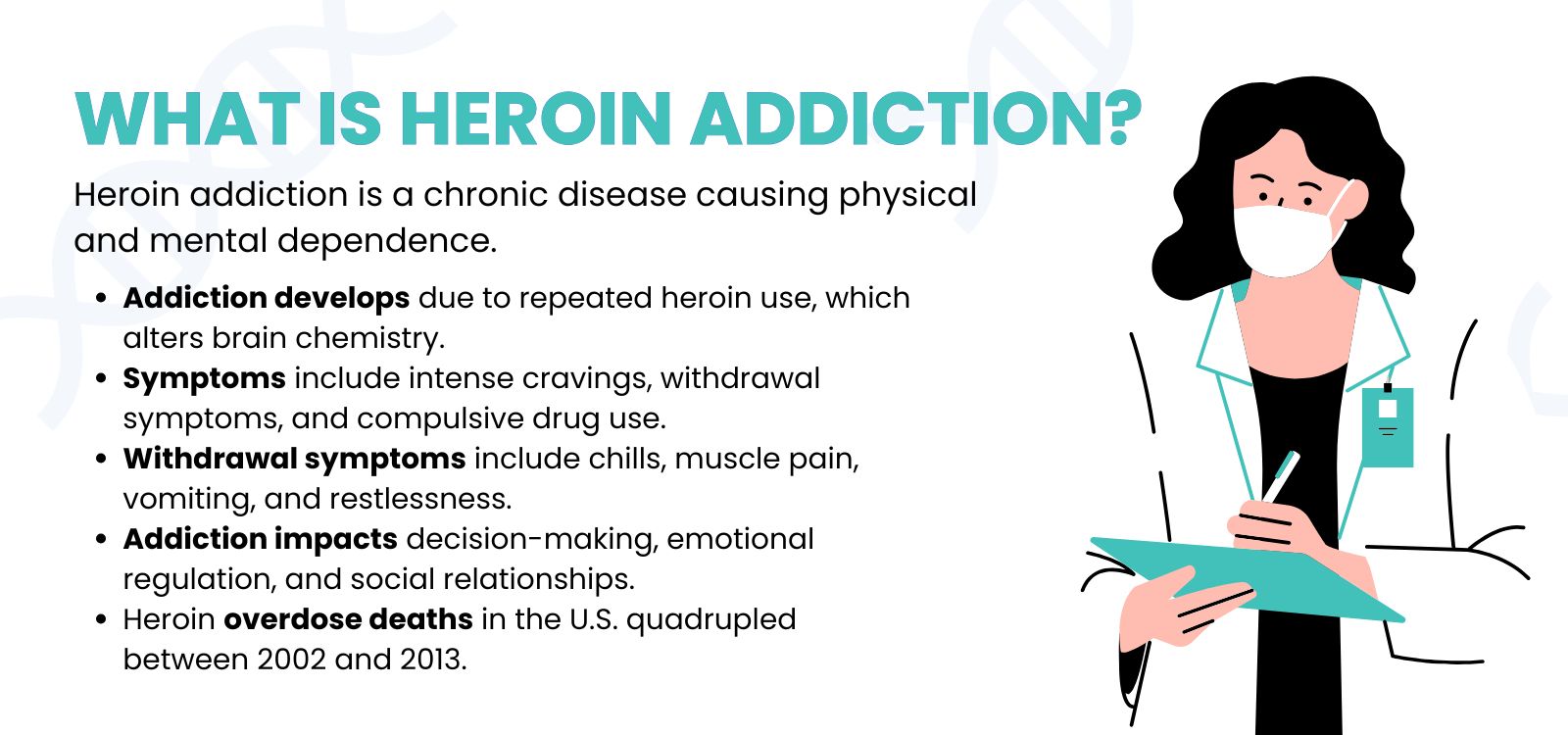
Heroin addiction is a chronic disease where a person becomes physically and mentally dependent on heroin, a highly addictive opioid drug. Heroin addiction develops when repeated use changes the brain, making it crave the drug and causing intense withdrawal symptoms like chills, spasms, and vomiting when the person tries to stop.
Heroin addiction has been a growing problem in the United States. Heroin overdose death rates nearly quadrupled between 2002 and 2013, rising from 0.7 deaths to 2.7 deaths per 100,000 people. The rates nearly doubled from 2011 to 2013 alone, according to the research titled “Vital Signs: Demographic and Substance Use Trends Among Heroin Users — United States, 2002–2013” by Christopher M. Jones and Joseph Logan, published by the Centers for Disease Control and Prevention.
How Addictive is Heroin?
Heroin is extremely addictive because it binds to opioid receptors in the brain and causes a rush of intense pleasure by releasing a flood of dopamine. Repeated use of heroin changes the brain’s chemistry and leads to dependence and a strong need to keep using the drug to avoid painful withdrawal symptoms.
What Does Heroin Look Like?
Heroin looks like a white or brown powder or a black, sticky substance called black tar heroin. Powdered heroin is mixed with other substances like fentanyl, cocaine, or caffeine, while black tar heroin has a thick, tar-like consistency due to poor processing methods.
Can Heroin Use Lead to Overdose?
Yes, heroin use can lead to overdose, especially when it is taken in large quantities or combined with other depressants such as alcohol, benzodiazepines, or barbiturates. A heroin overdose occurs when heroin suppresses vital functions such as breathing and heart rate, possibly causing unconsciousness, brain damage, or death. Synthetic opioids like fentanyl, often mixed with heroin, significantly increase overdose risks, according to research titled “Drug Overdose Deaths in the United States, 1999–2020” from the CDC, National Center for Health Statistics, 2021.
What Are the Withdrawal Symptoms of Heroin?
Withdrawal symptoms of heroin are intense cravings, muscle and bone pain, diarrhea, vomiting, cold sweats, insomnia, and restlessness, according to the research report titled “What are the long-term effects of heroin use?” by the National Institute on Drug Abuse. Withdrawal symptoms occur because the brain struggles to function normally after being dependent on heroin. The discomfort pushes people to relapse as they try to escape the painful withdrawal process.
Is Heroin Illegal?
Yes, heroin is illegal and is classified as a Schedule I substance in the United States under the Controlled Substances Act, as stated in the “Drug Scheduling” page by the United States Drug Enforcement Administration. Heroin has no approved medical use and it is prohibited to sell or distribute the drug.
What is Black Tar Heroin?
Black tar heroin is a less refined form of heroin that appears as a dark, sticky substance resembling tar. Black tar heroin is produced using crude processing methods and contains impurities, making it more dangerous. People who use black tar heroin usually inject it with needles or smoke it on foil. Injecting this form of heroin increases the risk of serious infections like abscesses, heart infections (endocarditis), and HIV.
Can mixing heroin with other drugs cause serious consequences?
Yes, mixing heroin with other drugs causes serious consequences. Combining heroin with other substances, such as alcohol, benzodiazepines, or synthetic opioids like fentanyl, leads to slow breathing and amplified heart rate, raising the risk of respiratory failure and death.
Can Mixing Heroin with Cocaine Cause an Increased Risk of Overdose?
Yes, mixing heroin with cocaine increases the risk of overdose. The combination of heroin and cocaine is called “speedballing”, which puts great stress on the body by overstimulating and repressing the central nervous system, leading to respiratory failure or cardiac arrest, according to the study titled “Speed-balling”: Mixing Stimulants and Opioids”, published by the Minnesota Judicial Branch.
Is the Risk of Coma Increased When Heroin and Benzos Are Used Together?
Yes, using heroin and benzos together increases the risk of coma. Both heroin and benzodiazepines depress the central nervous system, and their combined effect causes severe respiratory depression and unconsciousness, as stated in the study titled “Polydrug abuse: A review of opioid and benzodiazepine combination use” by Jermaine D Jones, Shanthi Mogali, and Sandra D Comer, published by the National Library of Medicine.
Can Mixing Heroin with Crystal Meth Lead to Unpredictable Heart Problems?
Yes, mixing heroin with meth leads to unpredictable heart problems. The stimulant effects of crystal meth strain the cardiovascular system, while heroin’s depressant effects create irregular heart rhythms, which increase the risk of heart attack.
Find Drug Rehabilitation Centers Near You Anywhere In the US
Addiction Resource team has compiled an extensive list of the top drug rehabilitation facilities around the country. Use our locator tool to find the best centers near you.


 Reviewed by:
Reviewed by: 


 FindTreatment.gov
FindTreatment.gov